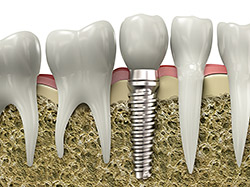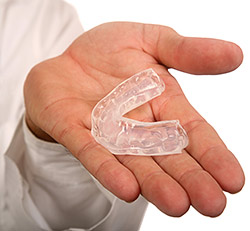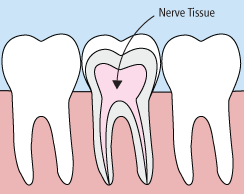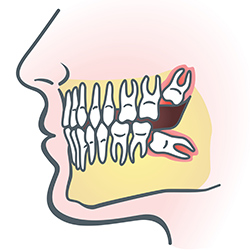Common Dental Procedures by Richard L. Raimondo, Jr. D.D.S. in San Antonio, TX
Topics on this page
As a general dentist serving the San Antonio, Schertz-Cibolo, and Universal City, TX communities for more than 40 years, Dr. Raimondo is experienced and qualified in all aspects of dentistry. Whether through simple preventive measures or full-mouth restoration, we hope to transform smiles and change the quality of our patients’ lives for the better.
Your best choice for dentistry in San Antonio!
- Non-Invasive Treatment Philosophy: The best dentistry is the least amount of dentistry necessary to keep your teeth healthy and beautiful
- Technology: Accurate shade-matching for crowns and restorations using Vita EasyShade®
- Experience: 44 years of experience to make the appointments smooth and comfortable
- Efficiency: Detailed treatment planning to minimize the number of visits and to maximize the amount of dentistry accomplished at each visit
- Comfort: Nitrous oxide/oxygen sedation (laughing gas) is available for a stress-free dental experience
- Excellence: From staff to treatments to results, nothing is substandard

Regular Exams and Cleanings
Regular exams are an important part of maintaining your oral health. During your regular exam, we will:
- Check for any problems that you may not see or feel
- Look for cavities or any other signs of tooth decay
- Inspect your teeth and gums for gingivitis and signs of periodontal disease
- Perform a thorough teeth cleaning
Your regular exam will take about 45 minutes. Each regular exam includes a detailed teeth cleaning, in which we will clean, polish, and rinse your teeth to remove any tartar and plaque that have built up on the tooth's surface.
Visiting our office every six months gives you the chance to talk to the doctor about any questions you may have about your oral health. Regular exams are offered by appointment only, so please contact our practice today to schedule your next dental exam and teeth cleaning.
Bonding
 Bonding is a conservative way to repair slightly chipped, discolored, or crooked teeth. During dental bonding, a white filling is placed onto your tooth to improve its appearance. The filling “bonds” with your tooth, and because it comes in a variety of tooth-colored shades, it closely matches the appearance of your natural teeth.
Bonding is a conservative way to repair slightly chipped, discolored, or crooked teeth. During dental bonding, a white filling is placed onto your tooth to improve its appearance. The filling “bonds” with your tooth, and because it comes in a variety of tooth-colored shades, it closely matches the appearance of your natural teeth.
Tooth bonding can also be used for tooth fillings instead of silver amalgam. Many patients prefer bonded fillings because the white color is much less noticeable than silver. Bonding fillings can be used on front or back teeth, depending on the location and extent of tooth decay.
Bonding is less expensive than other cosmetic treatments and can usually be completed in one visit to our office. However, bonding can stain and is easier to break than other cosmetic treatments, such as porcelain veneers. If it does break or chip, tell your doctor. The bonding can generally be easily patched or repaired in one visit.
Bridges
 A bridge may be used to replace missing teeth, help maintain the shape of your face, and alleviate stress on your bite.
A bridge may be used to replace missing teeth, help maintain the shape of your face, and alleviate stress on your bite.
A bridge replaces missing teeth with artificial teeth, looks great, and literally bridges the gap where one or more teeth may have been. Your bridge can be made from gold, alloys, porcelain, or a combination of these materials and is bonded onto surrounding teeth for support.
The success of any bridge depends on its foundation — the other teeth, gums, or bone to which it is attached. Therefore, it’s very important to keep your existing teeth, gums, and jaw healthy and strong.
Crowns

Crowns
A crown is a restorative treatment used to strengthen, stabilize, and improve the aesthetics of a tooth. It essentially becomes the new outer surface of your tooth above the gum line. Made from durable ceramic, crowns at our San Antonio dental office can restore your smile—and your life!
Are you a good candidate for a crown? You may be if:
- Your tooth is cracked and needs to have its strength restored
- You’ve undergone root canal treatment
- You have a tooth with a very large restoration (filling) that is compromising the tooth’s stability and aesthetics
- You need a fixed bridge that attaches to a crown
- You need a partial denture with the support of a crown
- You want to close gaps without braces, align some rotated teeth without braces, and achieve a “Hollywood Smile”
What makes crowns from Dr. Raimondo the best in San Antonio?
Experience! Besides having 44 years of clinical experience, Dr. Raimondo taught Crown & Bridge at the University of Texas Health Science Center Dental School at San Antonio for 26 years! He has the knowledge and expertise to fabricate exquisite restorations, but more importantly, he knows when to recommend a crown and when it is unnecessary.
If you do need a crown, you can rest assured that it will be of the highest quality and completely natural looking. Our shade selection and matching procedures involves computerized shade-matching using the VITA EasyShade® and digital photography to ensure the best possible color accuracy for your crowns. We use only the best United States dental labs and the best tested, long-lasting materials. Most importantly, you will be treated as a person—not as just another tooth that needs a crown.
Dentures

Dentures
Dentures may be necessary if you have lost, or must lose, all of your teeth in one or both dental arches. Dentures from our San Antonio dental office are made from high-quality acrylic and are a natural-looking, inexpensive way to restore speaking and chewing function.
You may be a good candidate for dentures if you:
- Do not have any natural teeth
- Are missing many teeth and the remaining teeth cannot support partial dentures
- Are missing many teeth and the remaining teeth are decayed beyond restoration
- Do not want or cannot have implants
Types of Dentures
A full denture replaces teeth with artificial teeth in either one or both dental arches. As there are no natural teeth present, the full denture rests entirely on gum tissue supported by underlying bone.
A partial denture replaces missing teeth with artificial teeth in either one or both dental arches. Since there are natural teeth present, these teeth are used to hold the partial denture in place and provide stability to the partial denture. The partial denture rests on both the remaining teeth and the gum tissue supported by underlying bone.
Dentures from Dr. Raimondo
Dentures from our San Antonio dental office are unique because of the precise technique used by Dr. Raimondo: the Staub Cranial Technique. This technique allows more accurate placement of the denture teeth, more accurate tooth borders, and customizable tooth size. This means that your dentures will look and fit better. Most patients tell us that they are the best they have ever had! Dr. Raimondo is one of a few San Antonio dentists to use this technique.
During your comprehensive examination at our San Antonio dental office, Dr. Raimondo will determine the condition of your dental ridges and review your medical history. He will discuss your history of having dentures and the problems you may have had in the past. It is also important for him to know what your expectations are for your dentures. Keep in mind that dentures are not natural teeth. They can look nice—a lot better than broken, missing teeth—but they will never function the same as your natural teeth once did.
Denture Care
Eating: You will be able to eat pretty much anything want. Many people have difficulty with sticky foods and fibrous foods like salads. Since dentures are not natural teeth, they will be less efficient at chewing food. Eating will get easier once you get used to having dentures.
Cleaning: Dentures and partial dentures should be thoroughly cleaned with toothpaste and a soft toothbrush on the tissue surface and the teeth surfaces once a day. They should be taken out and rinsed after every meal. Dentures and partial dentures should be taken out at night (to give the gums a rest) and placed in a denture soak (like Polident) to disinfect them and to keep them fresh. You should also rub the gums on the roof of the mouth and the floor of the mouth daily with gauze or a wet wash cloth.
Brushing: If you have a partial denture, brushing and flossing your remaining natural teeth is extremely important. Without proper daily home care, you will lose these remaining teeth as well.
Extractions
 There are times when it is necessary to remove a tooth. Sometimes a baby tooth has misshapen or long roots that prevent it from falling out as it should, and the tooth must be removed to make way for the permanent tooth to erupt. At other times, a tooth may have so much decay that it puts the surrounding teeth at risk of decay, so your doctor may recommend removal and replacement with a bridge or implant. Infection, orthodontic correction, or problems with a wisdom tooth can also require removal of a tooth.
There are times when it is necessary to remove a tooth. Sometimes a baby tooth has misshapen or long roots that prevent it from falling out as it should, and the tooth must be removed to make way for the permanent tooth to erupt. At other times, a tooth may have so much decay that it puts the surrounding teeth at risk of decay, so your doctor may recommend removal and replacement with a bridge or implant. Infection, orthodontic correction, or problems with a wisdom tooth can also require removal of a tooth.
When it is determined that a tooth needs to be removed, your dentist may extract the tooth during a regular checkup or may request another visit for this procedure. The root of each tooth is encased within your jawbone in a “tooth socket,” and your tooth is held in that socket by a ligament. In order to extract a tooth, your dentist must expand the socket and separate the tooth from the ligament holding it in place. While this procedure is typically very quick, it is important to share with your doctor any concerns or preferences for sedation.
Once a tooth has been removed, neighboring teeth may shift, causing problems with chewing or with your jaw joint function. To avoid these complications, your dentist may recommend that you replace the extracted tooth.
Fillings
 Traditional dental restoratives, or fillings, may include gold, porcelain, or composite. Newer dental fillings include ceramic and plastic compounds that mimic the appearance of natural teeth. These compounds, often called composite resins, are typically used on the front teeth where a natural appearance is important. There are two different kinds of fillings: direct and indirect. Direct fillings are fillings placed into a prepared cavity in a single visit. Indirect fillings generally require two or more visits. These fillings include inlays, and veneers fabricated with ceramics or composites.
Traditional dental restoratives, or fillings, may include gold, porcelain, or composite. Newer dental fillings include ceramic and plastic compounds that mimic the appearance of natural teeth. These compounds, often called composite resins, are typically used on the front teeth where a natural appearance is important. There are two different kinds of fillings: direct and indirect. Direct fillings are fillings placed into a prepared cavity in a single visit. Indirect fillings generally require two or more visits. These fillings include inlays, and veneers fabricated with ceramics or composites.
Fluoride
 Fluoride is effective in preventing cavities and tooth decay and in preventing plaque from building up and hardening on the tooth’s surface. A fluoride treatment in your dentist’s office takes just a few minutes. After the treatment, patients may be asked not to rinse, eat, or drink for at least 30 minutes in order to allow the teeth to absorb the fluoride. Depending on your oral health or your doctor’s recommendation, you may be required to have a fluoride treatment every three, six, or 12 months.
Fluoride is effective in preventing cavities and tooth decay and in preventing plaque from building up and hardening on the tooth’s surface. A fluoride treatment in your dentist’s office takes just a few minutes. After the treatment, patients may be asked not to rinse, eat, or drink for at least 30 minutes in order to allow the teeth to absorb the fluoride. Depending on your oral health or your doctor’s recommendation, you may be required to have a fluoride treatment every three, six, or 12 months.
Implant Restoration

Dental Implants
Dental implants at our San Antonio dental office are a state-of-the-art treatment to replace missing teeth. The implant itself is an artificial root that is placed in the jaw bone. Implants can be used to hold single replacement teeth (implant crown) or they can be used to hold multiple replacement teeth (implant fixed bridge). Implants can also be used to hold/stabilize a removable bridge (partial denture) or a full denture.
Dr. Raimondo has been restoring dental implants for more than 15 years, and works with the best oral surgeons in San Antonio to ensure a comfortable, successful implant placement.
Implants versus Bridges
Single-tooth implants can be used instead of fixed bridges to restore missing teeth. With a traditional bridge, the tooth next to the empty space needs to be crowned, even if it is otherwise healthy. An implant is a stand-alone restoration, meaning that the teeth adjacent to the empty space do not need to have crowns placed. It is more conservative and less invasive for the adjacent teeth.
Long-Lasting Restorations
An implant can last your lifetime. Success rates with the right surgeon, the right restorative dentist, and a non-smoking patient in good health are above 90%! Neither the implant itself (the artificial root) nor the restoration (crown, bridge, etc.) will fade, weaken, or change in appearance. You do need to care for your implant, treating it as a natural tooth with brushing, flossing, and professional cleanings. Excellent oral hygiene is a must for long-term success.
At the dental office of Dr. Raimondo, we can help you pick an outstanding oral surgeon, plan the restoration, and fabricate an exceptional implant crown to finish the restoration. Learn more by scheduling an appointment at our San Antonio dental office today!
Mouthguards
 Whether you wear braces or not, protecting your smile while playing sports is essential. Mouthguards help protect your teeth and gums from injury. If you participate in any kind of full-contact sport, the American Dental Association recommends that you wear a mouthguard. Choosing the right mouthguard is essential. There are three basic types of mouthguards: the pre-made mouthguard, the “boil-and-bite” fitted mouthguard, and a custom-made mouthguard from your dentist. When you choose a mouthguard, be sure to pick one that is tear-resistant, comfortable and well-fitted for your mouth, easy to keep clean, and does not prevent you from breathing properly. Your dentist can show you how to wear a mouthguard properly and how to choose the right mouthguard to protect your smile.
Whether you wear braces or not, protecting your smile while playing sports is essential. Mouthguards help protect your teeth and gums from injury. If you participate in any kind of full-contact sport, the American Dental Association recommends that you wear a mouthguard. Choosing the right mouthguard is essential. There are three basic types of mouthguards: the pre-made mouthguard, the “boil-and-bite” fitted mouthguard, and a custom-made mouthguard from your dentist. When you choose a mouthguard, be sure to pick one that is tear-resistant, comfortable and well-fitted for your mouth, easy to keep clean, and does not prevent you from breathing properly. Your dentist can show you how to wear a mouthguard properly and how to choose the right mouthguard to protect your smile.
Nightguards
 If you often wake up with jaw pain, earaches, or headaches, or if you find yourself clenching or grinding your teeth, you may have a common condition called “bruxism.” Many people do not even know that they grind their teeth, as it often occurs when one is sleeping. If not corrected, bruxism can lead to broken teeth, cracked teeth, or even tooth loss.
If you often wake up with jaw pain, earaches, or headaches, or if you find yourself clenching or grinding your teeth, you may have a common condition called “bruxism.” Many people do not even know that they grind their teeth, as it often occurs when one is sleeping. If not corrected, bruxism can lead to broken teeth, cracked teeth, or even tooth loss.
There is an easy, non-invasive treatment for bruxism: nightguards. Nightguards are an easy way to prevent the wear and damage that teeth-grinding causes over time. Custom-made by your dentist to fit your teeth, a nightguard is inserted over your top or bottom arch and prevents contact with the opposing teeth.
Root Canals
 In the past, if you had a tooth with a diseased nerve, you'd probably lose that tooth. Today, with a special dental procedure called “root canal treatment,” your tooth can be saved. When a tooth is cracked or has a deep cavity, bacteria can enter the pulp tissue and germs can cause an infection inside the tooth. If left untreated, an abscess may form. If the infected tissue is not removed, pain and swelling can result. This can not only injure your jawbones, but it is also detrimental to your overall health.
In the past, if you had a tooth with a diseased nerve, you'd probably lose that tooth. Today, with a special dental procedure called “root canal treatment,” your tooth can be saved. When a tooth is cracked or has a deep cavity, bacteria can enter the pulp tissue and germs can cause an infection inside the tooth. If left untreated, an abscess may form. If the infected tissue is not removed, pain and swelling can result. This can not only injure your jawbones, but it is also detrimental to your overall health.
Root canal treatment involves one to three visits. During treatment, your general dentist or endodontist (a dentist who specializes in problems with the nerves of the teeth) removes the affected tissue. Next, the interior of the tooth will be cleaned and sealed. Finally, the tooth is filled with a dental composite. If your tooth has extensive decay, your doctor may suggest placing a crown to strengthen and protect the tooth from breaking. As long as you continue to care for your teeth and gums with regular brushing, flossing, and checkups, your restored tooth can last a lifetime.
Sealants
 Sometimes brushing is not enough, especially when it comes to those hard-to-reach spots in your mouth. It is difficult for your toothbrush to get in-between the small cracks and grooves on your teeth. If left alone, those tiny areas can develop tooth decay. Sealants give your teeth extra protection against decay and help prevent cavities.
Sometimes brushing is not enough, especially when it comes to those hard-to-reach spots in your mouth. It is difficult for your toothbrush to get in-between the small cracks and grooves on your teeth. If left alone, those tiny areas can develop tooth decay. Sealants give your teeth extra protection against decay and help prevent cavities.
Dental sealants are plastic resins that bond and harden in the deep grooves on your tooth’s surface. When a tooth is sealed, the tiny grooves become smooth and are less likely to harbor plaque. With sealants, brushing your teeth becomes easier and more effective against tooth decay.
Sealants are typically applied to children’s teeth as a preventive measure against tooth decay after the permanent teeth have erupted. However, adults can also receive sealants on healthy teeth. It is more common to seal “permanent” teeth rather than “baby” teeth, but every patient has unique needs, and your dentist will recommend sealants on a case-by-case basis.
Sealants are usually long-lasting. It is fairly common to see adults with sealants still intact from their childhood. A dental sealant only provides protection when it is fully intact, so if your sealants come off, let your dentist know, and schedule an appointment for your teeth to be re-sealed.
Veneers
 You no longer need to hide your smile because of gaps, chips, stains, or misshapen teeth. With veneers, you can easily correct your teeth’s imperfections to help you have a more confident, beautiful smile. Veneers are natural in appearance, and they are a perfect option for patients wanting to make minor adjustments to the look and feel of their smile.
You no longer need to hide your smile because of gaps, chips, stains, or misshapen teeth. With veneers, you can easily correct your teeth’s imperfections to help you have a more confident, beautiful smile. Veneers are natural in appearance, and they are a perfect option for patients wanting to make minor adjustments to the look and feel of their smile.
Veneers are thin, custom-made shells made from tooth-colored materials (such as porcelain), and they are designed to cover the front side of your teeth. To prepare for veneers, your doctor will create a unique model of your teeth. This model is sent to the dental technician to create your veneers. Before placing your new veneer, your doctor may need to conservatively prepare your tooth to achieve the desired aesthetic result.
When your veneers are placed, you’ll be pleased to see that they look like your natural teeth. While veneers are stain-resistant, your doctor may recommend that you avoid coffee, tea, red wine, and tobacco to maintain the beauty of your new smile.
Wisdom Teeth
 Wisdom teeth are types of molars found in the very back of your mouth. They usually appear in the late teens or early twenties, but may become impacted (fail to erupt) due to lack of room in the jaw or angle of entry. When a wisdom tooth is impacted, it may need to be removed. If it is not removed, you may develop gum tenderness, swelling, or even severe pain. Impacted wisdom teeth that are partially or fully erupted tend to be quite difficult to clean and are susceptible to tooth decay, recurring infections, and even gum disease.
Wisdom teeth are types of molars found in the very back of your mouth. They usually appear in the late teens or early twenties, but may become impacted (fail to erupt) due to lack of room in the jaw or angle of entry. When a wisdom tooth is impacted, it may need to be removed. If it is not removed, you may develop gum tenderness, swelling, or even severe pain. Impacted wisdom teeth that are partially or fully erupted tend to be quite difficult to clean and are susceptible to tooth decay, recurring infections, and even gum disease.
Wisdom teeth are typically removed in the late teens or early twenties because there is a greater chance that the teeth's roots have not fully formed and the bone surrounding the teeth is less dense. These two factors can make extraction easier as well as shorten the recovery time.
In order to remove a wisdom tooth, your dentist first needs to numb the area around the tooth with a local anesthetic. Since the impacted tooth may still be under the gums and imbedded in your jaw bone, your dentist will need to remove a portion of the covering bone to extract the tooth. In order to minimize the amount of bone that is removed with the tooth, your dentist will often “section” your wisdom tooth so that each piece can be removed through a small opening in the bone. Once your wisdom teeth have been extracted, the healing process begins. Depending on the degree of difficulty related to the extraction, healing time varies. Your dentist will share with you what to expect and provide instructions for a comfortable, efficient healing process.
